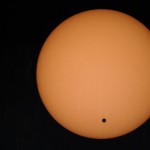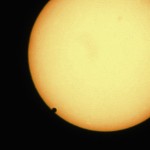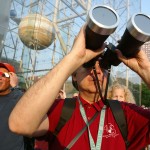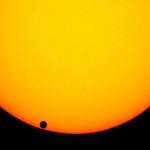Venus in Transit: How to Witness a Rare Astronomical Event in Texas
- A boy views the planet Venus through protected binoculars as it transits across the face of the sun as seen from the Greenwich Observatory June 8, 2004 in London. The rare astronomical event last occurred in 1882, while the next transit is due in 2012.
- This photo taken 08 June 2004 shows the transit of Venus across the sun’s disc through special spectacles, seen in the park of La Villette in Paris.
- People watch through telescopes the transit of Venus across the sun’s disc 08 June 2004 in the park of La Villette in Paris. Backgrouns is the Geode, a spherical Imax cinema
- The planet Venus is visible as a black dot as it transits across the facce of the sun June 8, 2004 as seen from Baghdad, Iraq. The rare astronomical event last occurred in 1882, while the next transit is due in 2012.
- Visitors observe the planet Venus passing in front of the Sun with filtered optics at the American Museum of Natural History June 8, 2004 in New York City. The transit of Venus is a rare celestial event which last occurred in 1882.
- The planet Venus is visible as a black dot as it transits across the face of the sun as seen from the Greenwich Observatory June 8, 2004 in London. The rare astronomical event last occurred in 1882, while the next transit is due in 2012.
- An Israeli child views the planet Venus as it transits across the face of the sun at Tel-Aviv university June 8, 2004 in Tel-Aviv, Israel. The rare astronomical event last occurred in 1882, while the next transit is due in 2012.
- The planet Venus is visible as a black dot as it transits across the face of the sun as seen from the Greenwich Observatory June 8, 2004 in London. The rare astronomical event last occurred in 1882, while the next transit is due in 2012.
It’s not quite an eclipse, it’s more like the sun is going to have a beauty mark for a rare, fleeting moment. On Tuesday, Venus (the brightest planet in our solar system) will pass in front of the sun, and if you’re hoping to catch it, plan with care. If you miss it, you won’t have another chance of seeing it until the next century. December 11, 2117, to be exact.
“During the transit, Venus will appear in silhouette as a small, dark dot moving in front of the solar disk,” writes EarthSky, which reports on astronomy and science. “Here in Austin, Texas, we’ll see the first half of the transit, while the second half will take place after the sun goes beneath our horizon. In North America, it’ll be to our advantage to find a level western horizon, as the sun will be low in the west at the time of the transit.”
For information on the best possible time to witness the phenomenon in Texas, check out local times from the Transit of Venus website. For much of the state, the transit will be viewable starting at 4 p.m. Tuesday and and ending around 10 p.m. You’ll want a telescope with a solar filter to safely observe the passing.
You can see a slideshow of the previous transit of Venus from 2004 above. If that seems recent to you, keep in mind that transits of Venus are usually in pairs. “They occur in a pattern that repeats every 243 years, with pairs of transits eight years apart separated by long gaps of up to 121.5 years,” EarthSky writes. “Before 2004, the last pair of transits were in December 1874 and December 1882.”
And before you go staring right into the sun (which you should never do), check out these helpful hints from NASA and EarthSky.







